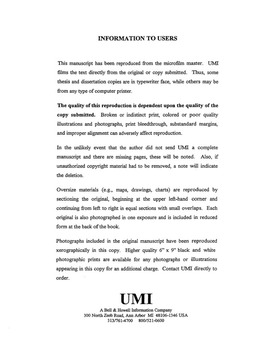| dc.contributor.advisor | Gronlund, Scott, | en_US |
| dc.contributor.advisor | Levine, Daniel, | en_US |
| dc.contributor.author | Nikolic, Danko. | en_US |
| dc.date.accessioned | 2013-08-16T12:30:31Z | |
| dc.date.available | 2013-08-16T12:30:31Z | |
| dc.date.issued | 1999 | en_US |
| dc.identifier.uri | https://hdl.handle.net/11244/5809 | |
| dc.description.abstract | Automatic processes are fast, effortless, mostly unconscious, take very little capacity and are slowly changing. Controlled processes are much slower, require effort and attention, require capacity, are closely tied to consciousness but provide high behavioral adaptivity in unfamiliar situations. Because this distinction is fundamental for virtually all aspects of human cognition it is important to understand the difference in the neurophysiological mechanisms that underlie these two aspects of cognition. Through computer simulations we show that the neural computations that rely on oscillatory and synchronous neural activity share several fundamental properties with controlled processes. By accounting for several experiments that first established the distinction between automatic and controlled processes in visual perception, we show that synchrony-based computations observe limitations in capacity and that processing time depends on the task complexity. We also show that synchrony-based computations have an ability to handle new, not previously encountered computations. Finally, we show that a learning mechanism that employs synchrony-sensitive changes of synaptic efficacy provides a good tool for developing automaticity. In other words, the system learns to develop synchronous patterns faster and more reliably and thus increases the speed and accuracy and decrease the demands on limited attentional resources. In sum, controlled cognitive processes seem to rely heavily on synchronous neural activity while automatic processes seem to employ synchrony-based computations to a far lesser degree. | en_US |
| dc.format.extent | viii, 86 leaves : | en_US |
| dc.subject | Psychology, Cognitive. | en_US |
| dc.subject | Cognitive psychology. | en_US |
| dc.subject | Biology, Neuroscience. | en_US |
| dc.title | Neurophysiological mechanisms underlying the distinction between automatic and controlled processes. | en_US |
| dc.type | Thesis | en_US |
| dc.thesis.degree | Ph.D. | en_US |
| dc.thesis.degreeDiscipline | Department of Psychology | en_US |
| dc.note | Source: Dissertation Abstracts International, Volume: 60-05, Section: B, page: 2015. | en_US |
| dc.note | Major Professors: Scott Gronlund; Daniel Levine. | en_US |
| ou.identifier | (UMI)AAI9929562 | en_US |
| ou.group | College of Arts and Sciences::Department of Psychology | |
